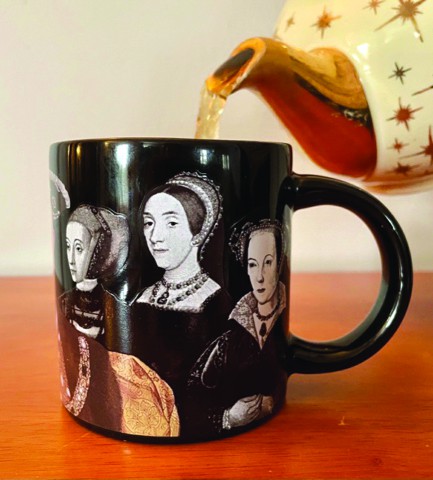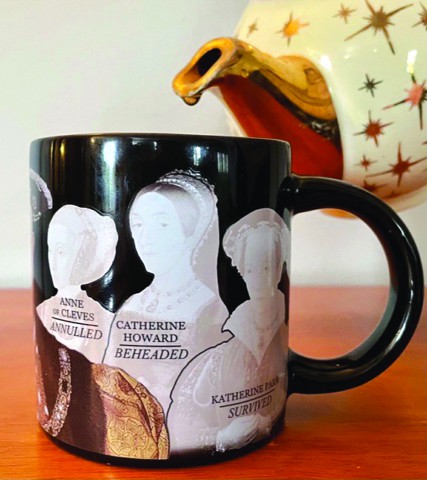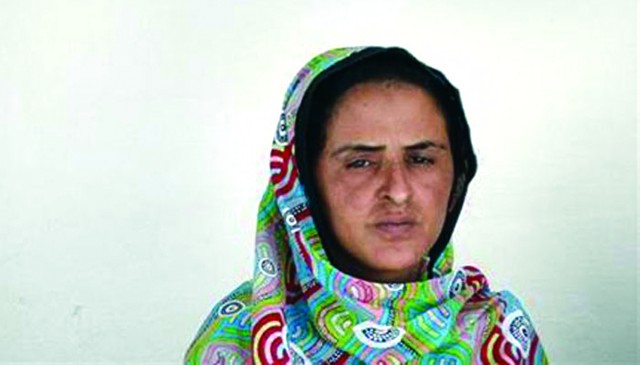
A few years ago, while visiting Stratford Upon Avon in Canada (Yes, there is a town by that name in Canada and like its counterpart in England, it is a theatre town), I bought a unique coffee mug in the theatre gift shop.
It had the likeness of King Henry VIII and his six wives. If one poured hot beverage into the mug, the three wives that Henry got rid of slowly disappear. When the beverage cools down, as if by magic, the wives reappear. Imagine a short lesson in history while sipping one’s coffee.
King Henry had a big problem. He couldn’t have a child and the Catholic Church would not allow him to divorce his wife. So, he found it convenient to have a few of them killed. Here is a poem about Henry and his wives by an unknown poet:
Boleyn and Howard lost their heads,
Anne of Cleves he would not bed,
Jane Seymour gave him a son – but died before the week was done,
Aragon he did Divorce,
Which just left Catherine Parr, of course!
While it is quite conceivable that the King wanted to have more than one wife, it is also possible that a few of them could have been barren. Such a situation always raises the question: is it him or her that is the problem? In case the problem was with the King, he could have obtained the services of some unscrupulous pir or pandit from the Subcontinent. In that case, the woman’s life could have been spared. But in King Henry’s time there was no mystic and self-proclaimed holy man like Rasputin, a confidant of the family of Nicholas II, the last Tsar of Russia.

The reality is that in a man’s world, women have always been considered a dispensable commodity.
Women constitute half the population of the world. Yet, in almost every walk of life, they are held back. While in some places, attitudes have been changing, the gap between men and women persists. This includes disparity in pay between men and women performing the same job. In America, a woman earns less than a man for the same job.
There is an interesting story about Sandra O’Conner the late Justice of the US Supreme Court. After graduation with distinction from Stanford University Law College, she could not find a job as a lawyer. She was offered a secretarial job. It was her sheer determination that she went from an unpaid secretary, to assistant county attorney, to elected member of Arizona State Senate, to Arizona State Court of Appeals and then on to the US Supreme Court. Not many mortals are able to overcome deeply entrenched attitudes about women.
Discrimination against and abuse of women is not limited to the Third World countries. It is pervasive all over the word. When I came to the US in the early 1960s, I was surprised and amazed at the apparent comfort level between men and women in the workplace. I thought, naively, that the Western societies had achieved a measure of maturity in male-female relationships. The horrid revelations about sexual exploitation of women in the workplace in America were eye openers. Not to mention former President Trump who is on record to have boasted about “grabbing” women by the privates and sexually abusing them with impunity.

When we point to so few women in leadership positions, we often hear an opposing argument. Examples are given of Benazir Bhutto of Pakistan, Indira Gandhi of India, Sheikh Hasina of Bangladesh, Megawati Sukarnoputri of Indonesia and Sirimavo Bandarnaike of Sri Lanka. These women, capable as they were, rode on the coattails of their politician fathers to become prime ministers. It is next to impossible for an exceptionally competent and brilliant woman from an ordinary background to reach the pinnacle of power in those countries.
Most Third World countries are patriarchal societies. By discouraging and keeping women down, they practice a sort of ‘female infanticide’ that was common in the Arab pre-Islamic society. Many years ago, I met a well-meaning and enthusiastic man championing the cause of women’s education in Pakistan. He was promoting and raising funds for a private Women’s University. He gave me a beautiful flyer explaining the purpose and need for such an institution. There was one glaring omission, however; there was not a single woman on the proposed board of the university! How shameful!
It is said that a woman can’t perform at the level of a man. The truth is that except for physical strength, women can hold their own against men. They are as good and sometimes better in areas of business, science, literature, and music. In addition, women can give birth and nurture children. Women are more peaceful and possess the ability to resolve conflicts by non-violent means. It has been said that women would refrain from starting wars.

But why are there so few women, as opposed to men, in the forefront of human activities? Because for millennia women have been denied the opportunity of leadership, education, and intellectual pursuits. Religion, customs, culture, and most importantly, men stood in the way.
Dr. Nasim Ashraf, one-time minister in the cabinet of General Pervez Musharraf, had initiated a unique program when he was the president of the Association of Physicians of Pakistani Descent (APPNA). APPNA Sehat was a self-help program initiated at the village level in selected places in the four provinces. Among other findings, it became obvious that if the mother was educated, even if nominally, the children did well regarding health and education. The educational status of the father did not make much difference.
Then there is another ugly aspect of male-dominated societies: rape. During the 1947 Partition of India, there were widespread rapes committed by Muslims, Hindus, and Sikhs. Manto’s masterpiece short story Khol Do (Open up) illustrated the ugly face of rape of a Muslim girl committed by her co-religionists. Then there were rapes committed by the Serbs against Bosnian women during the Bosnian war in the early 1990’s. The United Nations labeled that as “crimes against humanity.” Before and during WWII, the Imperial Japanese Army forced girls and women into prostitution in occupied territories. They called them with the innocent-sounding name of “comfort women.”
In 2002, a woman named Mukhtaran Bibi, was gang raped by four men of a powerful Mastoi clan in Meerwala village in Punjab. The case received international attention. Initially, the men were convicted to die by hanging, but the higher courts commuted their sentences to life imprisonment. It is possible they would go unpunished.
In the early 1950’s, there was this mentally deranged young homeless woman in Peshawar. She wore tattered clothes and occasionally no clothes at all. That caused the people to do everything to cover her body. She ate whatever people gave her. Then she became pregnant. She wandered in the streets with a swollen belly and people looked down upon her and shunned her. Gone were the God-fearing people who would try to put clothes on her. They assumed the women had the capacity to ward off her rapist. None of them tried to find the culprit.
So, she roamed the bazaars and streets of the city carrying the “bundle of shame” to the embarrassment of the noble and pious citizens.
Maurice Maeterlinck, the Belgian playwright, philosopher and 1911 Nobel Laureate in Literature had famously said that at every crossroads that leads to the future, tradition has placed 10,000 men to guard the past.
There is a palpable link between the wives of King Henry, widespread rape of women in Bosnia, the mentally unstable pregnant women in Peshawar, Mukhtaran Mai and countless other unknown victims. They were all at the mercy of men.
The proverbial ten thousand men were always there to help perpetuate injustices against the women.
Dr. Sayed Amjad Hussain is an emeritus professor of surgery and an emeritus professor of humanities at the University of Toledo, USA. His is also an op-ed columnist for the daily Toledo Blade and daily Aaj of Peshawar
It had the likeness of King Henry VIII and his six wives. If one poured hot beverage into the mug, the three wives that Henry got rid of slowly disappear. When the beverage cools down, as if by magic, the wives reappear. Imagine a short lesson in history while sipping one’s coffee.
King Henry had a big problem. He couldn’t have a child and the Catholic Church would not allow him to divorce his wife. So, he found it convenient to have a few of them killed. Here is a poem about Henry and his wives by an unknown poet:
Boleyn and Howard lost their heads,
Anne of Cleves he would not bed,
Jane Seymour gave him a son – but died before the week was done,
Aragon he did Divorce,
Which just left Catherine Parr, of course!
While it is quite conceivable that the King wanted to have more than one wife, it is also possible that a few of them could have been barren. Such a situation always raises the question: is it him or her that is the problem? In case the problem was with the King, he could have obtained the services of some unscrupulous pir or pandit from the Subcontinent. In that case, the woman’s life could have been spared. But in King Henry’s time there was no mystic and self-proclaimed holy man like Rasputin, a confidant of the family of Nicholas II, the last Tsar of Russia.

The reality is that in a man’s world, women have always been considered a dispensable commodity.
Women constitute half the population of the world. Yet, in almost every walk of life, they are held back. While in some places, attitudes have been changing, the gap between men and women persists. This includes disparity in pay between men and women performing the same job. In America, a woman earns less than a man for the same job.
There is an interesting story about Sandra O’Conner the late Justice of the US Supreme Court. After graduation with distinction from Stanford University Law College, she could not find a job as a lawyer. She was offered a secretarial job. It was her sheer determination that she went from an unpaid secretary, to assistant county attorney, to elected member of Arizona State Senate, to Arizona State Court of Appeals and then on to the US Supreme Court. Not many mortals are able to overcome deeply entrenched attitudes about women.
When I came to the US in the early 1960s, I was surprised and amazed at the apparent comfort level between men and women in the workplace. I thought, naively, that the Western societies had achieved a measure of maturity in male-female relationships
Discrimination against and abuse of women is not limited to the Third World countries. It is pervasive all over the word. When I came to the US in the early 1960s, I was surprised and amazed at the apparent comfort level between men and women in the workplace. I thought, naively, that the Western societies had achieved a measure of maturity in male-female relationships. The horrid revelations about sexual exploitation of women in the workplace in America were eye openers. Not to mention former President Trump who is on record to have boasted about “grabbing” women by the privates and sexually abusing them with impunity.

When we point to so few women in leadership positions, we often hear an opposing argument. Examples are given of Benazir Bhutto of Pakistan, Indira Gandhi of India, Sheikh Hasina of Bangladesh, Megawati Sukarnoputri of Indonesia and Sirimavo Bandarnaike of Sri Lanka. These women, capable as they were, rode on the coattails of their politician fathers to become prime ministers. It is next to impossible for an exceptionally competent and brilliant woman from an ordinary background to reach the pinnacle of power in those countries.
Most Third World countries are patriarchal societies. By discouraging and keeping women down, they practice a sort of ‘female infanticide’ that was common in the Arab pre-Islamic society. Many years ago, I met a well-meaning and enthusiastic man championing the cause of women’s education in Pakistan. He was promoting and raising funds for a private Women’s University. He gave me a beautiful flyer explaining the purpose and need for such an institution. There was one glaring omission, however; there was not a single woman on the proposed board of the university! How shameful!
It is said that a woman can’t perform at the level of a man. The truth is that except for physical strength, women can hold their own against men. They are as good and sometimes better in areas of business, science, literature, and music. In addition, women can give birth and nurture children. Women are more peaceful and possess the ability to resolve conflicts by non-violent means. It has been said that women would refrain from starting wars.

But why are there so few women, as opposed to men, in the forefront of human activities? Because for millennia women have been denied the opportunity of leadership, education, and intellectual pursuits. Religion, customs, culture, and most importantly, men stood in the way.
Maurice Maeterlinck, the Belgian playwright, philosopher and 1911 Nobel Laureate in Literature had famously said that at every crossroads that leads to the future, tradition has placed 10,000 men to guard the past
Dr. Nasim Ashraf, one-time minister in the cabinet of General Pervez Musharraf, had initiated a unique program when he was the president of the Association of Physicians of Pakistani Descent (APPNA). APPNA Sehat was a self-help program initiated at the village level in selected places in the four provinces. Among other findings, it became obvious that if the mother was educated, even if nominally, the children did well regarding health and education. The educational status of the father did not make much difference.
Then there is another ugly aspect of male-dominated societies: rape. During the 1947 Partition of India, there were widespread rapes committed by Muslims, Hindus, and Sikhs. Manto’s masterpiece short story Khol Do (Open up) illustrated the ugly face of rape of a Muslim girl committed by her co-religionists. Then there were rapes committed by the Serbs against Bosnian women during the Bosnian war in the early 1990’s. The United Nations labeled that as “crimes against humanity.” Before and during WWII, the Imperial Japanese Army forced girls and women into prostitution in occupied territories. They called them with the innocent-sounding name of “comfort women.”
In 2002, a woman named Mukhtaran Bibi, was gang raped by four men of a powerful Mastoi clan in Meerwala village in Punjab. The case received international attention. Initially, the men were convicted to die by hanging, but the higher courts commuted their sentences to life imprisonment. It is possible they would go unpunished.
In the early 1950’s, there was this mentally deranged young homeless woman in Peshawar. She wore tattered clothes and occasionally no clothes at all. That caused the people to do everything to cover her body. She ate whatever people gave her. Then she became pregnant. She wandered in the streets with a swollen belly and people looked down upon her and shunned her. Gone were the God-fearing people who would try to put clothes on her. They assumed the women had the capacity to ward off her rapist. None of them tried to find the culprit.
So, she roamed the bazaars and streets of the city carrying the “bundle of shame” to the embarrassment of the noble and pious citizens.
Maurice Maeterlinck, the Belgian playwright, philosopher and 1911 Nobel Laureate in Literature had famously said that at every crossroads that leads to the future, tradition has placed 10,000 men to guard the past.
There is a palpable link between the wives of King Henry, widespread rape of women in Bosnia, the mentally unstable pregnant women in Peshawar, Mukhtaran Mai and countless other unknown victims. They were all at the mercy of men.
The proverbial ten thousand men were always there to help perpetuate injustices against the women.
Dr. Sayed Amjad Hussain is an emeritus professor of surgery and an emeritus professor of humanities at the University of Toledo, USA. His is also an op-ed columnist for the daily Toledo Blade and daily Aaj of Peshawar

